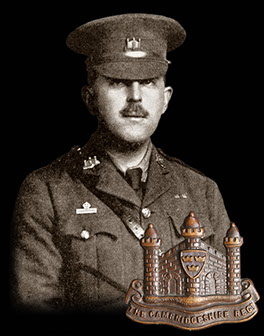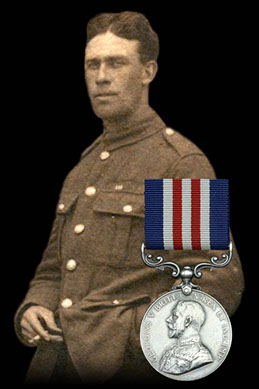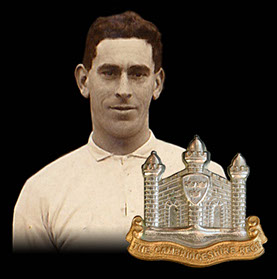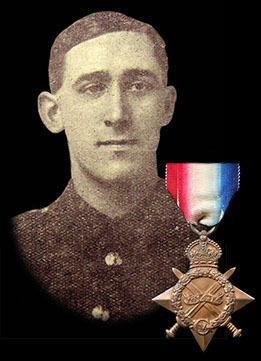
Who Were
The Cambs
The Cambs
at War
1/1st Btn 1914-1919
1914 - 1/1st Overview
1915 - 1/1st Overview
1915 - St Eloi
1915 - Fosse Wood
1916 - 1/1st Overview
1916 - The Schwaben
1916 - St Pierre Divion
1917 - 1/1st Overview
1917 - St Julien
Insignia, Medals & Books
Remembering The Cambs
Biographies
About Us &
This Site
Back in the Line & an Immediate MM - April 1916
Having left the safety of a winter in the Third Army Training School at Flixecourt, the 1/1st Cambridgeshire Regt joined the 39th Division, making up one of four Territorial Force battalions in its 118th Brigade.
The last day of March 1916 saw selected officers and Company Sgt Majors visit the Moated Grange Sector at Pont du Hem (in front of Laventie), which was described in the battalion war diary as “a first line breastwork with a few supporting points behind – most of them marked down by the Bosche guns. Communication trenches afford cover up to the waist. Mine craters opposite our right centre.”
So it was that on April 1st the battalion marched to Pont Du Hem, via Merville, La Gorgue and La Bassee road, to become the brigade reserve and to reacquaint themselves with trench routine – the first time up the line since October 25th, 1915. A day later the commanding officer, Lt-Col Goodwyn L Archer was slightly wounded during a visit to the HQ of 1/1st Herts, a sister battalion in 118th Brigade. The same shell killed a Herts officer, Lt W.W. Park, and wounded the chaplain Rev J Howse. Two days later (April 4th) the Cambs relieved the Herts in the left sector (Moated Grange) with A, C and D Companies in the first line and B Company in detached posts.
First casualty among the other ranks was L/Cpl Albert Frost, of Great Shelford, who was in C Company and was slightly wounded in the leg on April 4th.
On the night of April 5/6th a patrol from C Company under L/Cpl Harry Eggett went out at night and came under fire. Eggett, a farm labourer from Outwell, near Wisbech, was wounded. Pte Frank Drage, from Wisbech, acted with great coolness, binding the wounded man’s leg and helping him back under heavy machine gun fire. It earned Drage a recommendation for the newly created Military Medal.
Both Eggett and Drage had joined up in September 1914 and went out to France with the battalion on February 14th, 1915. Eggett was invalided to the UK, later promoted to Sergeant and served in East Africa with the King’s African Rifles from October 1917. Coincidentally, Drage had been posted to the KAR in May 1917.
On the same day, Pte Roland Morris, of Ely, who was in D Company, was wounded in his shoulder and spine by shellfire. He was taken to 1/2nd London Casualty Clearing Station at Merville, where he died of wounds the next day. He is buried at Merville Communal Cemetery. The next day Pte Maurice Buck, a laboratory assistant at Cambridge University’s School of Agriculture, was left suffering from a severe case of shell shock and was evacuated back to England on April 11th. He was discharged from the Army in 1918 and returned to work at the school.
Two days later the battalion was relieved and went into the support line, taking over from the Herts Regt.
By the middle of the month the Cambs Regt had moved into the Festubert sector, an area of heavy fighting in 1915. The 39th Division had taken over an area previously held by 38th Division and the Cambs men were distributed along the village support line in ruined buildings. The battalion war diary states: “The posts are in a very dilapidated condition.”
On April 19th the Cambs Regt relieved the Herts Regt in the left of the front line with A and D Companies placed in what was called the OBL (Old British Line) – described in the war diary as “a good breastwork containing a fair number of dugouts built more for comfort than to stand the hardships of war.” B Company were in posts called islands at Canadian Orchard. These islands are described as “isolated trenches, partially joined up on the left of north end, holding generally garrisons of one NCO and six men, not connected up with the cover trench which is manned in parts and runs along some 80 to 100 yards in the rear.” The frontage held by the Cambs Regt formed a loop pushed out into the German line during May 1915.
Such was the danger of being spotted in these inadequate trenches, the war diary adds: “In the day time communication by runner with anyone in front of the OBL is a thing to be carried out only in an emergency.”
During this spell at Festubert the casualties, mainly in D Company, were:
Cpl Martin ‘Dick’ Kirby, a printer from Wisbech, was wounded on April 20th and posted to England where he served in the 3/1st Btn before returning to the 1/1st Btn and being awarded the MM on July 31st 1917 at St Julien. In August 1917 he transferred to the Royal Engineers and died of influenza on November 19th, 1918, being buried at St Andre Communal Cemetery, Nord, France.
Sgt Dennis Peck, a motor engineer from March, was wounded in the face on April 22nd while outside the trench. He could not be carried to safety until darkness.
Pte Henry ‘Harry’ Cross, of Littleport, who was wounded on April 22nd, 1916 and later on July 31st, 1917. Posted to the Labour Corps, he died on November 16th, 1918 and is buried at Littleport Cemetery.
Pte Arthur Ernest Gray, a servant at Emmanuel College, Cambridge, was wounded on April 22/23rd.
Pte Harry Hall, of Haddenham, who was wounded on April 23rd and as a L/Cpl was killed in action on July 31st, 1917 at St Julien. He has no known grave and is listed on the Menin Gate Memorial at Ypres.
L/Cpl John William West, of Stuntney was slightly wounded on the same day as Hall, but returned to duty only to receive a head wound on June 30th, 1916 and die of his wounds a day later. He is buried at Merville Communal Cemetery, close to Roland Morris.
The battalion was relieved during the night of April 23/24th and marched back to Le Touret. The casualties had been light, but there were darker days ahead. Over the remaining few days of the month those 160 men who had not had leave since the battalion went to the Western Front in February 1915 began to get their passes for home.
April 30th was Easter Sunday and at the church parade, the First Army commander, Gen Sir Charles Monroe presented Drage, now promoted to L/Cpl, with the MM for gallantry on the patrol on April 5/6th. The temporary adjutant, Lt Tom Formby wrote in the war diary: “He is one of the first men to receive the Military Medal.”
The citation survives (rare for the MM):
For gallant conduct when on patrol at Moated Grange. The patrol was fired on and the leader hit. Pte Drage bound him up and assisted him back to our lines under a heavy machine gun fire. The man had previously done good work.
The award was listed in the London Gazette June 3rd, 1916.
Back to the top of the page.

Lt Col Archer in 1915.

Sgt Frank Drage MM later in the war.

Harry Eggett in 1917.

Maurice Buck from Cambridge.

This site went live on the 14th February 2015 to mark 100 years since the 1/1st Cambs went off to war.
WE WILL REMEMBER THEM
Email us: cambsregt@gmail.com
Copyright 2015, 2016, 2017, 2018, 2019 by Felix Jackson. The information and images on this site should not be reproduced without prior permission.